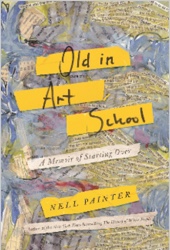A Distinguished History Professor Retires—Then Goes to Art School
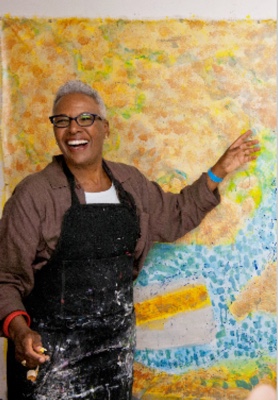
Professor Nell Painter, Artist
(Detail, John Emerson Photo)
In my history books I have already had my say in clear language and discursive meaning about community. Now what history means to me in images is freedom from coherence, clarity, and collective representation. Nell Painter, Old in Art School
At age 64, Nell Irvin Painter retired from her chaired history professor position at Princeton University. During her distinguished career as a historian and teacher she was acclaimed for her pioneering research and writing on American history, race, and social change.
After such a celebrated career as a professor and bestselling author, most retirees would go off quietly to rest on their laurels. But not Professor Painter. She soon embarked on an “encore career,” determined to reinvent herself as an artist on her own terms. Rather than paint or draw on her own schedule at home, she undertook a rigorous course of academic study first at the Mason Gross School of Art at Rutgers University, near her home in Newark, New Jersey, and then in the demanding graduate program at the Rhode Island School of Design.
Professor Painter recounts her journey from academic historian to art student to working artist with candor, humor, and wisdom in her new book, Old in Art School: A Memoir of Starting Over(Counterpoint Press). She reveals her doubts and frustrations as well as her determination and resilience as an art student in courses where she was told she would never be “an Artist.” At the same time, her act studies were complicated by her efforts to care for her elderly and frail parents who lived in faraway Oakland, California.
In her memoir, Nell Painter also considers her sense of “invisibility” as an “old, black lady” in art school and in an art world dominated primarily by white males. And she discusses her artistic influences and the making her own art. The book includes dozens of images of her multifaceted, imaginative creations.
Professor Painter was the Edwards Professor of American History at Princeton University and also the Director of Princeton's Program in African-American Studies. She has served as president of the Southern Historical Association and of the Organization of American Historians and also as an officer of many other professional organizations, including the American Historical Association, the American Antiquarian Society, the Association for the Study of Afro-American Life and History, and the Association of Black Women Historians. Her books of history include Exodusters: Black Migration to Kansas After Reconstruction (1976); The Narrative of Hosea Hudson: His Life as a Negro Communist in the South (1979); Standing at Armageddon: The United States, 1877-1919 (1989); Sojourner Truth: A Life, A Symbol (1996); Southern History Across the Color Line (2002); Creating Black Americans: African American History and Its Meanings, 1619 to the Present (2005); and The History of White People (2010).
After retirement from Princeton, Professor Painter earned a BA in art from the Mason Gross School of Art at Rutgers University and an MFA from the Rhode Island School of Design.Since then, she has devoted her life to making art. She has received a fellowship in art from Yale as well as other commendations and her art has been widely exhibited and collected.
Professor Painter generously spoke by telephone from her home in New Jersey about her career as a pioneering history professor and her experience in art school and beyond.
Robin Lindley: Congratulations Professor Painter on your fascinating new memoir, Old in Art School. It’s wise, funny, and inspiring. It’s much different than your books of scholarly history, though extremely detailed. Did you keep detailed notes during your art school days?
Nell Painter: Yes. When I decided to go to art school, people asked me to take notes because they wanted to know what it was like. The research was largely in my own journals, but there was also checking up on the artists I wanted to write about to insure what I said about them was true.
Robin Lindley: Full disclosure: I’m 69 now. I’ve worked mostly as a lawyer and writer. I like to draw and paint, but I don’t think I’d have the fortitude to go back to art school—especially after reading of your challenges after your distinguished career as a history professor. You retired early from your chaired professorship at Princeton at age 64 at the height of your career. Did you leave because you wanted to pursue art?
Nell Painter: Yes. I thought I had finished The History of White People. It turns out I really hadn’t.
I was at a point where I had trained a lot of young historians. I found that what I was doing with my dissertation advisees was repetitious in the sense that I was teaching them to write. To me, you think by writing. You also need to do research, obviously, but that was something I didn’t really have to teach them to do. But to get out and to put down you want to say, to me, means writing. Then you revise, and you discover you need to write some more. And you revise, and write some more, and that’s the way to get to what you say.
That’s also what I needed to say as a writer of memoir. I couldn’t have said the things that I said in the book until I had gone through about three or four revisions.
Robin Lindley: You moved away from scholarly writing and created this very vivid and accessible memoir.
Nell Painter: I had help from my agent who has experience in this kind of writing. It didn’t come easily or naturally. She helped me write in a way that was honest and revealing by asking probing questions.
Robin Lindley: It seems that you retired somewhat early as a celebrated professor at Princeton. Was there anything about the school then that prompted your decision to retire when you did?
Nell Painter: Yes. It was the sense that I was having to struggle over the same struggles of 30 years earlier. It was a sense that things hadn’t budged in terms of hiring black faculty, for instance. And I remember having low-key struggles with women’s studies. I said I’m just not doing this again.
The big thing that struck me in the History Department was that I was alone in wanting to hire particular people. This was not a generalized thing. My allies and I had our eyes on really marvelous historians. In one case, there was a person who not only was brilliant and whose professional career could not be assailed, and who also was the sweetest person in the world, and I heard some of my colleagues attack his character. That was totally untrue. Those of us who wanted to see him join us said that. I discovered looking around and talking to other people that this is a tactic not only in my department but had occurred in many other places. It had actually been used against me in some places to say that I was difficult, that I was a trouble maker, that I was anti-black. Things that simply were not true. My professional bona fides could not be assailed. And it wasn’t just me. That was profoundly discouraging.
And then to hear my colleagues in women’s studies say the same things that people said years earlier. I said okay. I have other things to do. It was time for younger people to take on the struggle.
Robin Lindley: I’m sorry you had to go through that.
Nell Painter: It wasn’t just me. This is the country we live in.
Robin Lindley: I wanted to turn to your interest in art. As a little girl, did you dream of becoming an artist?
Nell Painter: No. I didn’t know what it meant to be an artist. I loved to draw and I drew a lot, but that did not translate into what I would do with my life.
My father taught me to draw. He loved to draw and he loved woodworking. That was his hobby and he did that until glaucoma made it impossible to see well. But also, he suffered from depression which makes it impossible to do anything. It can stifle everything. It’s just devastating.
Robin Lindley: As an undergraduate at Berkeley, you started to study art. Why did you drop art then and change your major?
Nell Painter: I got a C in sculpture, which was the appropriate grade, as I didn’t do any work in that class. I thought talent would suffice. It didn’t.
Robin Lindley: Did you decide to change your major to history at Berkeley after leaving art?
Nell Painter: No. I graduated in anthropology. Anthropology was the place where I could study all kinds of people. Back then I thought American history was a pack of lies. I did not study American history as an undergraduate. I went to a very good high school and tested out of the American history requirement for all freshmen at Berkeley.
Robin Lindley: What inspired you to study history?
Nell Painter: I discovered history in another country where I didn’t have the baggage that I had with American history. That was during my junior year abroad in France and it was just intellectual curiosity about the place where I was living in Bordeaux. I studied French history. I still love French history. I listen to podcasts on France Culture radio on French history—and now I’m listening to a series on American history on the financial crisis of 2008. It’s in French with a French point of view.
Robin Lindley: Did you go directly from undergraduate to graduate school for history?
Nell Painter: No. After I graduated, I joined my parents in Ghana during the socialist revolution in Kwame Nkrumah’s Ghana. I come from a left-wing family from Oakland and we were going to make the revolution there.
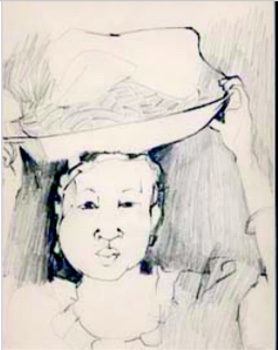
Nell Painter, Ghana Drawing of Girl, 1964-65.
Robin Lindley; How did your experience in Ghana influence your decision to go onto graduate school in history?
Nell Painter: First of all, history had changed. We’re talking about the mid-1960s. The history that was being written then and that I read was very different from the history I had studied in high school. Maybe if I had studied history as an undergraduate at Berkeley, I might have seen something different.
In Ghana, what came together was my interest in the historical context of what was happening as in Bordeaux and in Ghana. And then, questions stirred me—questions of development, for instance, and those were very pertinent in Ghana. Then I began to free myself of my American orientation of one of the most important things, if not the most important thing, and that was race. In Ghana, it was not pertinent, so questions of development, and questions of culture, and questions of economic class surged to the fore and I was absolutely fascinated and I wanted to continue that.
When I started graduate school at Harvard, I actually started in African history but I got there before the African historian. I was very unstable intellectually. I was taking American history and was very interested, so I stuck with that.
Robin Lindley: Was your dissertation on African American history?
Nell Painter: Yes. Exodusters, on the migration from the Deep South to Kansas following Reconstruction.
Robin Lindley: How did the story of these migrants capture your interest?
Nell Painter: They prompted a question: why did they leave home? As someone who had moved around a lot myself, migration seemed to me like a reasonable response to the violence that ended Reconstruction. But answers weren’t obvious in the historiography.
Robin Lindley: Who were your mentors in graduate school at Harvard?
Nell Painter: Frank Friedel was my advisor and he taught me what I needed to know to get started. One thing he taught me, which I passed on to my students, was if you’re going to write an effective dissertation or book, you need to start with a robust archive—a robust set of primary sources. If you don’t have that, you don’t have a likely topic. And he said that the quickest way to find out if there will be a robust archive is to just look in The New York Times Index, and if there are a lot of entries on your topic, then you will find a lot of other materials. That was the first thing he had me do, and I did find several entries the led me to source material.
Robin Lindley: That’s great advice. And then you went on to a distinguished career as a historian and professor and you wrote several pioneering books of American history. How do you see your experience as a historian over the course of your academic career? How did your views of our history and race evolve over that time?
Nell Painter: It wasn’t so much that things hadn’t ever changed, but it was like people had reverted, like going backwards. One big difference—I got my PhD in 1974—and I had friends in college who were interested in left-wing history, African American studies and history, working class studies, and immigration. We were few in number then, but we thought we were the leading edge. We thought there would be a lot of people coming after us, and that turned out not to be the case right away. In the long run, it did turn out to be the case. But there were difficulties in hiring, academic inertia, and all, and we felt very lonely into the mid-eighties. It took that long for things to turn around.
Ultimately, in the course of all those years, I have felt one big change that all of that scholarship has made: that’s in the popular discourse. We’re facing so many challenges now in 2018 that are still exactly like 1968, but in 1968 we did not have the ballast of all this scholarship and all of this discussion and all of these public intellectuals with access to mainstream outlets. For instance, I use social media, and one of the pieces I shared in the last or so was by Jelani Cobb who is an academic who writes regularly for The New Yorker. To have someone like him writing for The New Yorker and therefore reaching millions of people couldn’t have happened in 1968. And we have others like Katha Pollit in The Nation and Ta Nahesi Coates, who reach large audiences. So there are lots of people now. Earlier, one person, James Baldwin, had to shoulder the burden of explanation all on his own. And he had to talk to a much less informed general American population. So things have changed in terms of our national intellectual discourse.
Robin Lindley: You certainly see more discussions in the media now about slavery, the Civil War, the Confederacy and white supremacy, and Jim Crow segregation.
Nell Painter: Yes. There’s long been that discussion within left-wing communities and African-American communities, but now they are national topics of debate. I think Trumpism is a reaction to the opening of this wider avenue of discussion.
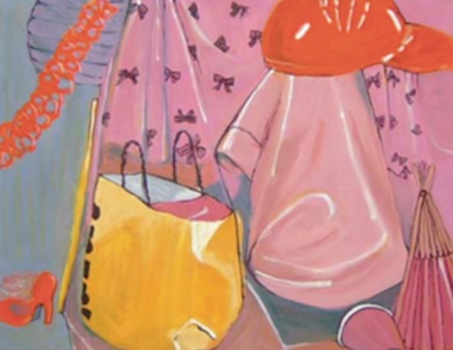
Nell Painter, Red Hat,2003
Robin Lindley: Your own historical work is important in understanding our past. To go onto your decision to go back to art school at age 64, people asked why can’t you just make art on your own? Why a demanding academic program? Did you want to accomplish certain things by earning degrees in art?
Nell Painter: I wouldn’t say that I wanted to accomplish certain things, but I knew step-by-step that the way to do the work I wanted to do entailed formal study.
I first said to myself I want to take more time making art. I’m a knitter so I’ve had my hand in the visual arts in that sense, but to I wanted to be more concerted about it. And people said you can work out of your own life, out of your own imagination, and said you’ve got a good mind and a good imagination. You can make art the way you want to. And so on.
Well, I didn’t have enough in my head to go forward. Before I enrolled in the undergraduate program at Rutgers, I tried taking courses. My Princeton colleagues very generously let me take two introductory painting courses. I discovered I really enjoyed that and also that I needed to learn the things I was learning.
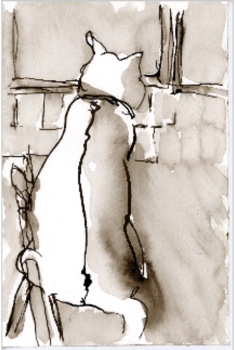
Nell Painter, Ro, 2008
Then I took the drawing and painting marathon at the New York Studio School, and that really is a studio school. There was no art history or art criticism, and I missed those things. I missed a real library and I missed discussion of the meaning of what we were doing. The point of the Studio School was to teach you to paint like Paul Cezanne, and I wanted to do more than that.
I realized, when I experienced those limitations, that I needed something else. Rutgers with the Mason Gross School of Arts is a very good institution and within reach, so that’s what I did. I decided to go straight onto graduate school [skipping a fourth undergraduate year at Rutgers] because I felt held back and stymied and frustrated by the feckless undergraduates. You know from the book about my mother’s illness and my father’s illness later and all the complications about whether I made a bad decision. That was a bad decision, but I made it and I did work hard.
Robin Lindley: You vividly describe your hard work, resilience, and fortitude. I was stunned by the dismissive attitudes of some of your fellow students and your teachers, especially in graduate school at the Rhode Island School of Design, where teachers said you would never be an artist and students were indifferent. They weren’t at all curious about your experience. Yet you persisted in a very demanding program.
Nell Painter: I had a lot of help. I couldn’t have done it without what I call my “alternative crits.” It was one of the places where I felt that my age really helped because I had a sense of myself that was not totally dependent on other people. When you’re young, how will you do that? How are you going to know? If I had encountered those experiences when I was young, I might have done as many others have done, and that is to quit. But I was old enough to have a wonderful circle of friends outside and to have a sense of myself.
Robin Lindley: That support seemed critical during art school. You stress that getting an MFA was more difficult than earning your doctorate in history.
Nell Painter: That’s true. With my PhD in history, I knew what I needed to do. I had a good sense of when I was doing the right things and asking the right questions and finding answers that made sense and what I needed to do more of. The path was clearer. It seemed so mysterious in art school and I felt so often off balance.
Robin Lindley: So you had objective criteria with history but art was virtually all subjective?
Nell Painter: Absolutely. Art is not entirely all about taste, but a lot of judgment around art and what is valued in art is about taste. And tastes change and vary from person to person. And there is more than one art world. There’s a big The Art World, but there are other art worlds. A person like me who is not fashionable in The big Art World finds people in a smaller art world who are interested in my work.
Robin Lindley: How did your background as an academic historian and professor influence your experience in art school.
Nell Painter: At first it was a handicap because I was hung up on meaning—meaning in the discursive sense, the historical sense, the sense of factual meaning. I had to learn visual meaning.
While I was learning visual meaning, I experienced my academic background as a handicap. Over the years, I think I’ve been able to pull that together so I’m more at ease now using history and politics in art. The politics of our time are so important that it threatens to invade all my art.
This summer, I made a series of six pieces with a rubber stamp. They’re small, 9 inches by 12 inches. They’re called Année Infâme, the “Infamous Year.” And they’re all stamps of 2016. Bringing the political and historical into my art is easier for me now than it was six years ago.
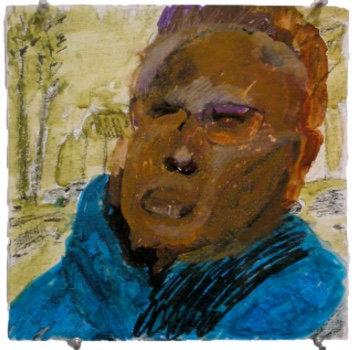
Nell Painter, Self-Portrait 5, 2010.
You’ve mentioned in the book that you saw through twentieth-century eyes in your art work. Does that mean you were reflecting an older style in your art?
Nell Painter: Yes. It was the aesthetics I had grown up with, that I had absorbed in looking at the world and looking at art over the course of the twentieth century, and that’s where my ideas about what art should look like had taken shape—without my realizing it, of course. And I learned in art school that that’s not what my peers and my teachers in the art worlds around me were seeing and making.
It’s like with history now—although I haven’t written any history for a few years. The history I wrote in The History of White People[in 2010] is a different history than I wrote in Exodusters in the seventies. The questions we ask of the past change according to the world we’re living in. I don’t think any historian would be surprised by that. It’s the same thing with art. What we ask and seek in the visual realm changes over time as well.
Robin Lindley: Your eventual triumph in bringing history and art together was wonderful to read. I loved your series called Art History by Nell Painter. You write of artists you admired such as Ben Shahn and Max Beckmann and Alice Neel. It seems you have a kinship with the expressionists. You probably don’t want to be pigeon-holed, but do you consider yourself a sort of Neo-expressionist?
Nell Painter: I call myself a maker of artist books, which is a very unfashionable way to make art. I work in series, and working in series is more like printmaking than easel painting.
I don’t fit anywhere easily. I’m not going to be hot artist because makers of artist’s books are not hot artists. Artist’s books are hard to sell. I get great pleasure in making series, like the “2016” series. That’s why I make art: for the satisfaction or the pleasure or contentment. For the freedom. So I don’t have to become a great artist or a hot artist. I don’t have to sell my work for a lot of money. These are gifts to me so I can make whatever art I want. I can make unfashionable art, which I do.
Robin Lindley: It seems you’ve found your niche as an artist. I was impressed by the work you did in the summer before your final year of graduate school at RISD, and your students and teachers were awed by how your work developed in a short time.
Nell Painter: It’s because, again, I had support. During that summer, one of my neighbors, the painter Frank Owen, came over and gave me the kind of crit I would have loved to have had early on. That kind of support makes all the difference in the world, but it also takes getting out from under eyes that are not interested in what you’re doing. That experience of mine of finding my own way of making art in the summer between the first and second year is not uncommon. It is common actually for graduate students to do that.
Robin Lindley: I also learned so much from your book on how artists are judged, not only by the academic world but also by the world of galleries and collectors.
Nell Painter: We have markers in history and in publication. For artists, people ask the name of your gallery, and then type you by how cool your gallery is. In publication, people ask who your publisher is, and figure out where you stand in the hierarchy in accordance with who publisher is. Or, in history, where you teach. Or whether you’re an assistant professor or associate professor or full professor or chaired professor. We have all those ways in the academy of figuring out where people stand.
Robin Lindley: That regimentation in the art world is mysterious. You’ve talked about dealing with race as a professor. The art world has been run largely by white people, for white people. Has that been changing in terms of women and people of color in the arts? What do you see happening?
Nell Painter: I don’t know. I do see, from reading The New York Times, changes in the ranks of curators in various museums, and that’s a big step forward, assuming that has happened.
Robin Lindley: A recent show at the Seattle Art Museum called “Figuring History” featured the work of three prominent, living African American painters: Robert Colescott, Kerry James Marshall, and Mickalene Thomas. That seemed to indicate a willingness at this museum to share the work of contemporary black artists.
Nell Painter: It’s better than nothing, but the big question is whether this sort of thing is sustained, and if it leads to acquisitions, and if those acquisitions are on display. With those different steps, each one is on a step to regularizing, routinizing the desegregation of museums of what we can see.
In the 1960’s and 1970’s there was a lot of talk about desegregating museums. Some museums actually bought work, but they didn’t know what to do with it, so they stuck in storage, or they’d bring it out on occasion and say “here’s our black artist.”
The trick is to sustain black artists and to sustain consciousness of their work and to sustain showing of their work, and to show their work in a context that is not simply labeled by race. That is, each artist belongs in a cohort, say a chronological cohort or a group of figurative artists or, like Colescott, who belongs to a school called “Bad Painters.” These are ways of integrating black artists without saying “Oh, here’s a black artist.”
Robin Lindley: I agree that it’s important to recognize these artists as American artists regardless of race or gender or other background. I wanted to also ask you about the aspect of being old in art school. Your story is very moving, particularly in terms of caring for your ailing elderly parents in California while taking on demanding studies in art school on the East Coast. You traveled cross-country to help your mother and father.
Nell Painter: I have two things to say. One is asking when are you old in art school? After about the age of 28. When are you old as a woman? You start getting that message as you approach 40. I could have been old in art school much younger than I actually was. But as you become old as a woman you start being invisible, and that’s not just in art school—that’s in society generally. That was a lot of what I encountered in art school: being treated as an invisible person or not treated because I was invisible.
But, also part of being old is caring for our parents who live past 85 when people start getting weak and needy. You inherit your parents no matter what you’re doing. On the one hand, an old woman is an invisible woman. On the other hand, the child of old, old parents is someone who cannot let them go. The fact of being old and having parents whether your male or female, but especially if you’re a daughter, entails a life of its own.
Robin Lindley: It had to be so grueling to travel across the country at a moment’s notice to be with your parents. That’s when I would have quit art school.
Nell Painter: It was grueling. And I was really tempted [to quit]. We stayed in the Adirondacks one summer after we had moved my parents into assisted living and we weren’t sure how they were doing to do. I knew I didn’t totally disrupt a semester so we stayed out. My husband was on sabbatical and actually, I took a printmaking class at SUNY Plattsburg. I’m still friends with my printmaking teacher and I learned techniques that I used on my “2016” pieces. She taught me how use rubber stamps.
Robin Lindley: And you’ve continued taking courses even after getting your MFA.
Nell Painter: Yes. You could say that, though it was very informal. You always learn. That’s lifelong learning.
Robin Lindley: I love your drawing and how you use modern technology such as Photoshop and other digital collaging techniques. You’re an inspiration. I’m just learning to draw on an iPad.
Nell Painter: Photoshop and Illustrator are very powerful. I can’t use all of the features even though it’s taken me years. Just start and then you can do more and more and more. Take a course in Photoshop or whatever interests you. It’s like knitting. You need to sit with somebody.
Robin Lindley: You book is inspiring as you encourage people to continue their education regardless of age.
Nell Painter: Good. But I think we need to continue our education no matter how old we are with our eyes wide open knowing that education is often calibrated for people in their early twenties, and that is not always appropriate for people who are older.
Robin Lindley: On the issue of invisibility, you’ve also mentioned that sense or the feeling of not belonging in terms of race. You express that powerfully, and your resilience comes through.
Nell Painter: I thank my parents for that.
Robin Lindley: Their example must have helped your through periods of self-doubt and that sense of invisibility.
Nell Painter: When I say I thank my parents, it’s not for that. My husband was much more the support in that sense because my parents were across the country. But, when I was a kid, they were very supportive.
Both my parents were educated, so I never had problems with them explaining what I wanted to do. They just said, “Go ahead and do it.” They were comfortable enough financially as ordinary, middle-class people, so I never felt that I was pursuing what I was doing at their expense or cheating them by using money that might be better spent for them. No, that never came up, and I’m very grateful for that. There was always an ease between me and my parents with their understanding what I wanted to do was what I was doing.
When I started art school [after retirement from Princeton] in my first semester at Mason Gross at Rutgers, my father had received a small inheritance and he gave it to me to pay my tuition.
Robin Lindley: That’s a wonderful gift. Do you have any other thoughts for readers or for those who may want to consider what may be called a career transition?
Nell Painter: Yes, they call it “an encore career.” I do have something I’d like to say.
Don’t look for yourself, your older self, reflected in our society. So much in our society is calibrated to young people, whether people in their twenties, or people in their thirties, or in their forties. But in their fifties or their sixties. Or their seventies? No, no. We are invisible once we get past 60. If you look for your own self in popular culture, you may not find yourself. What you want to do and how you see yourself have to come from inside and not depend on what society shows you, because it’s so seldom shown to us old people. Say it loud: I’m old and I’m proud.
Robin Lindley: I enjoyed your almost palpable expression of freedom on completion of your studies for an MFA. And you’ve gone onto make all kinds of art, receive a fellowship at Yale, and find a true niche for your special art. That’s so inspiring.
Nell Painter: Good. I’m not the person I was being trained to be. I was being trained to be a hot young white male artist. No. That’s not what I am. I’m a modest little old black lady artist.
Robin Lindley: It’s been an honor to talk with you Professor Painter. Congratulations on your profound and wise new memoir—and thank you again for your pioneering work as a historian. I look forward to more of your art.
